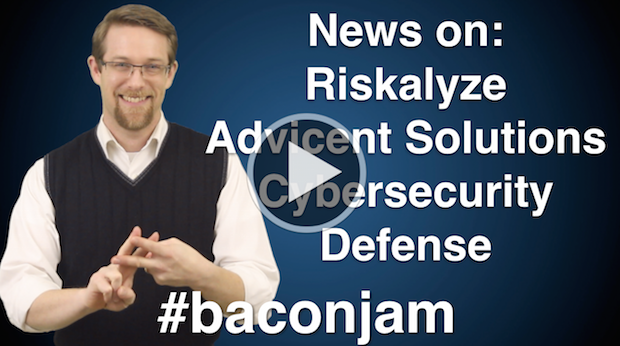On today’s broadcast, Riskalyze enhances its best client facing technology with a fresh new interface, Advicent adds new integrations for Schwab Intelligent Technologies, and, get my best cybersecurity tips to protect your business from hacking, phishing, and spoofing attacks.
So get ready, FPPad Bits and Bytes begins now!
(click to watch FPPad Bits and Bytes on YouTube)
But first, if you are interested in supporting future episodes of FPPad Bits and Bytes, find out how you can become a sponsor to reach a fantastic audience of advisors looking to grow their business with technology. Visit fppad.com/advertise for more information on how you can help support this show.
Oh, and check out the #baconjam at Carson Kitchen in Las Vegas. It is to die for!
Here are the links to this week’s top stories:
The Industry’s “Best Client Facing Technology” Just Got Better from Riskalyze
[Now this week’s top story comes from Riskalyze, the provider of risk tolerance assessment tools for advisors, as this week the company announced an all-new dashboard and client profile interface.
The new interface is clean, designed to be easy to navigate, and is overall very user friendly. For example, profiles prominently display the risk number of a client’s existing portfolio, the risk of a portfolio proposed by the advisor, and a probability percentage from the Riskalyze Retirement Map feature I mentioned back in episode 129.
As the winner of my best client-facing technology award in 2013, Riskalyze raises the bar once again with its new look and feel, but the company is also enhancing the nuts and bolts of what goes on behind the scenes. If you’re not yet using a formal risk assessment tool in your business, Riskalyze deserves to have a spot on your list of contenders.] One of the things our customers love the most about Riskalyze is how simple and easy it is to use. Today, we’re doubling down on that with the launch of an all-new Riskalyze dashboard and client profile, the Advisor-Set Risk Number and simpler stress tests.
Advicent Launches Two New Integrations for Schwab Intelligent Technologies™ from PRWeb
[Next up is news on Advicent Solutions, a provider of financial planning and marketing communication tools to advisors. Earlier this week, Advicent announced to new integrations with Schwab Intelligent Technologies™.
First, if you monitor client accounts using the Schwab PortfolioCenter Hosted™ solution, you will be able to import account values into the NaviPlan® financial planning application using the Schwab OpenView Gateway™ integration. If you don’t use Schwab PortfolioCenter Hosted, you can still import values from Schwab Advisor Center using the integration the company announced last year.
Second, a new integration was announced for those of you who use the Profiles™ financial planning software tool from Advicent. Just like NaviPlan, Profiles now supports account information imports from Schwab Advisor Center as well, helping you save time when importing account values into plans built with Profiles.
If you don’t custody assets with Schwab, you’ll be glad to know that Advicent has been busy building integrations with other providers in recent months, including TD Ameritrade Institutional’s Veo Open Access, Redtail CRM, Morningstar Office, Appcrown, and Orion Advisor Services.] Advicent Solutions, a Milwaukee-based SaaS provider, adds two new integrations for Schwab Intelligent Technologies™ to help financial advisors manage their time more effectively.
How to Keep Client Data Safe From Online Attackers from Financial Planning, and
Download my Defend Against Hacking, Phishing, and Spoofing Attacks guide from FPPad.com
[And finally, I traveled to Las Vegas this week where I presented at the AICPA Advanced Personal Financial Planning conference. I gave a room full of CPAs tips and techniques to protect their business from hacking, phishing, and spoofing attacks.
Financial Planning magazine sent Maddy Perkins to cover my session, and she did a terrific job capturing the risks to your business and the defensive strategies you can implement.
Visit fppad.com/151 to get the link to the story in Financial Planning, and while you’re there, you can also link to my free three-page PDF on all the tips, strategies, and resources I covered during my presentation.] Just hours before he was going to give a presentation on online security for advisors, Bill Winterberg lost his phone at the AICPA Personal Financial Planning Conference. Luckily, thanks to a plan he has for just such an occasion, he found it.












